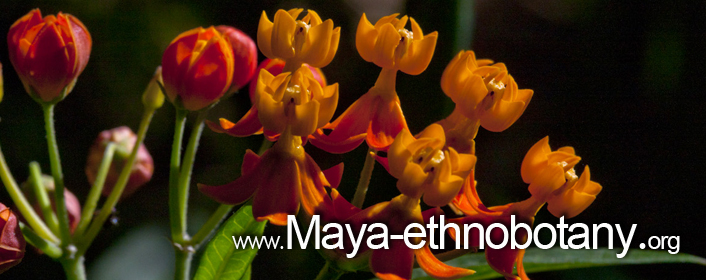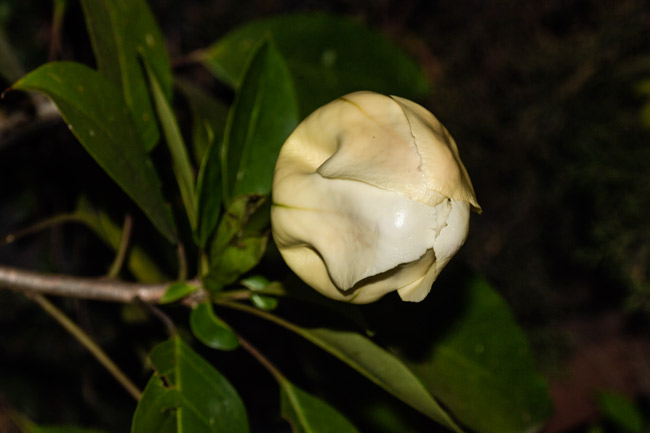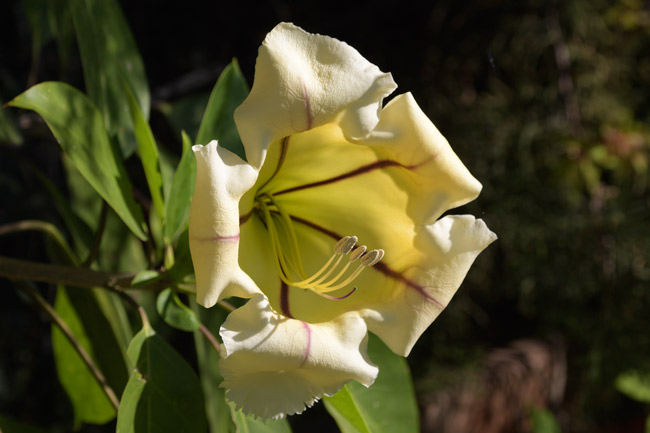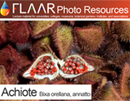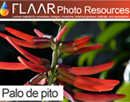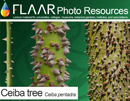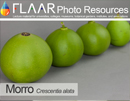When time and funding permit, each flower (each plant species) will have its own page, and its own PDF, and eventually its own PPT so that professors and students have plenty of material on Guatemala (and Honduras, etc) to study.
Heliconia adflexa, Coban, Guatemala, Hotel Monja Blanca, FLAAR, by Nicholas Hellmuth
This space is for flowers
we have recently found and photographed.
|
| Share
|
| Solandra maxima, cup of gold, flowering at night in Guatemala |
|
Many plants of the family Solonaceae flower at night: Ipomoea alba is one; Solandra maxima, cup of gold is another. There are so many flowers of Guatemala that bloom at night. Many are vines, many are cactus. We are interested in finishing our list of all night blooming flowers, and then finding the eco-system where each grows, learning in which month they flower, and then having our team of photographers with specialized equipment and lots of experience doing stop-action sequences to record these flowers as they bloom. Which pollinators work at night? Aristoloca is potentially the tallest flower of Guatemala. Datura and Brugmansia are fairly long but Brugmansia is not native to the Mayan or Aztec areas. For width, I estimate that the flowers of Solandra maxima are in the âtop 10â for sure (and probably in the âTop 3â) flower sizes of Guatemala. I have not yet seen a flower this wide in Guatemala (Brugmasia flowers can be wide but they are not native). Datura are rarely cultivated in gardens so I have no measurements for their flower width. I am using the name Solandra maxima; if a botanist indicates this is a synonym or is otherwise incorrect, we appreciate corrections. Flowers of Solandra maxima sort of wilt during full sun The flowers are in full bloom in the early morning. Where the plant is growing it takes several hours for the sun to find a path to shine through all the trees: during the hours that the sun is directly on the flower, it literally âwilts.â
We noticed no odor, and no pollinators of the flower of Solandra maxima I came out to photograph the opening of the flower every several minutes (after it was fully open). During the one hour opening process I was there half the time (FLAAR has capable photography assistants who can take photos of time lapse on their own). Before the flower opened there were occasionally insects the size of really tiny ants on the bud. But I saw no pollinators the first hour it was open. Of course our studio lights and the flash of the two cameras could easily have scared pollinators away. For further information on Solandra maxima, cup of gold, Ratsch is available Even though I was a student at Harvard in the 1960âs, I do not eat, drink, or smoke Solandra maxima, or Dactura, or Cecropia leaves. Even though I visited Palenque frequently in the 1960âs and 1970âs, I do not eat, drink, or smoke mushrooms that were infamous for Palenque in those years. Plants of the Solanaceae family (Nightshade family) vary from toxic to hallucinogenic Yet potatoes and tomatoes are also of the Solanaceae family. And one of the common garden flowers in Mesoamerica, Brugmansia, is also of the family Solanaceae (but best not even to breathe too much Brugmansia scent). Brugmansia is not native to Guatemala but is popular in gardens because it is so easy and fast to grow and flower. Plus Solanum wendlandii is stated to be edible by local Qâeqchiâ Mayan people. The vines we have in our office in Guatemala City come from gardens in Cahabon, Alta Verapaz. Here and in many other areas Solanum wendlandii is a common garden plant. I estimate that not many people eat it, even though they know Quixtán So for plants of the Mayan world you do not need to focus on Solandra maxima. But it is definitely interesting to try to figure out when the bud will burst into bloom. I estimate that the precise hour will depend a bit on weather, but 7 pm was when the flower started (finally, after we had cameras set up THREE DAYS). Mayan culture did indeed use many of the same happy plants that the Aztec and prehispanic people all over Mexico used (surely the Greeks, Romans and everywhere else also figured out what plants could get them happy too). But I prefer to be able to watch the petals or sepals of a flower getting ready to spring into action to open.
First Posted March 13, 2018 |
Parque Nacional Yaxha, Nakum and Naranjo
Carnivorous Plants
Plants of Municipio de Livingston, Izabal
- Acrostichum danaeifolium, giant leather ferns
- Bellucia Pentamera
- Bibliography on Grias cauliflora
- Bibliography on Licania platypus
- Bibliography on Mangle negro (Avicennia germinans) L.
- Bibliography on Montriacardia arborescens
- Bibliography on Typha domingensis and Thypha latifolia
- Conocarpus erectus, white mangrove
- Edible Wetlands Plants, Hotel Tortugal
- Heliconia latispatha
- Heliconia wagneriana
- Manicaria saccifera Confra palm
- Neotropical trees of Guatemala need protection
- Nymphoides indica, waterlily flowers
- Pachira aquatica, zapoton
- Bibliography on Pithecellobium Mart., Neotropical trees of Mesoamerica
Ecosystems, Wetlands Aquatic Plants
Smartphone Camera Reviews
Bushes and small trees
Fungi and Lichens
Orchids
- Bibliography Bletia purpurea, aquatic orchid
- Bibliography, Epidendrum radicans
- Bibliography on Habenaria Orchids from Yaxha
- Bibliography, Lycaste virginalis var. alba.
- Bibliography, Macroclinium bicolor
- Bibliography, Prosthechea cochleata
- Bibliography Sobralia macrantha, Lirio de San Juan
- Bibliography, Sobralia xantholeuca
- Bibliography on Terrestrial shade orchids from Guatemala
- Bibliography on Terrestrial sunny orchids from Guatemala
Botanical Terms
Maya and Aztec flavorings for cacao, cocoa, chocolate
- Achiote, Bixa orellana
- Bibliography on Achiote, Bixa orellana
- Bibliography on Esquisúchil, Bourreria huanita
- Bourreria huanita
- Cassia grandis, bucut
- Chile Chocolate
- Chile Chocolate (Capsicum annuum var accuminatum)
- Chiranthodendron pentadactylon
- Cymbopetalum penduliflorum
- Guazuma ulmifolia
- Haematoxylum brasiletto
- Piper auritum, hoja santa
- Piper species
- Quararibea funebris
- Sterculia apetala, castaño
- Tagetes sp., Marigold
- Talauma, a variant of Magnolia
- Vanilla orchid
- Virola and nutmeg
Cacao, cocoa, chocolate
Consulting cacao & Theobroma species
Tobacco Ingredients of Aztec & Maya
Trees of Mesoamerica
- Bibliography on Acacia dolichostachya, Wild tamarind
- Bibliography, Bellucia costaricensis
- Bibliography, Bucida buceras
- Bibliography on Coccoloba belizensis Standl.
- Bibliography on Cojoba sp. and Cojoba arborea
- Bibliography, Ficus.
- Bibliography on Haematoxylum campechianum and H. brasiletto
- Bibliography on Hibiscus pernambucensis
- Bibliography on Ipomea murucoides
- Bibliography on Lacmellea standleyi, lechemiel
- Bibliography on Leucaena leucocephala
- Bibliography on mangle rojo (Rhizophora mangle)
- Bibliography on Manzanillo, Alseis yucatanensis Standl.
- Bibliography on Matilisguate, Tabebuia rosea
- Mangrove swamp Trees
- Bibliography on Ruagea insignis
- Bibliography on Pterocarpus officinalis
Bombacaceae, Bombacoideae
Tropical Fruits of the Maya
- Avocado Hass
- Bibliography on Coloc, Talisia floresii
- Bibliography, Dichogamy of avocado species
- Bibliography on Guayo, Talisia olivaeformis
- Bibliography on Laetia thamnia, Bakelac
- Bibliography on Maracuyá, Passiflora quadrangularis L.
- Bibliography on Punica granatum L., Granada
- Cashew
- Cuajilote, Parmentiera aculeata
- Granada
- Guanabas and Annonas
- Guava, Guayaba, Psidium guajava L
- Introduction to Papaya
- Nance a fruit of prehispanic Guatemala
- Passion flowers and fruits
- Passion flower, giant fruit
- Talisia floresii, Sapindaceae
- Carica Papaya Bibliography
Tropical Nuts
Spices, condiments, food coloring
Medicinal Plants
- Aristolochia, The largest flower in Guatemala, Bibliography
- Asclepias curassavica, bibliography
- Bibliography on Ciricote, Cordia dodecandra
- Bibliography on Contrahierba, Dorstenia contrajerva
- Bibliography on Falso hibisco, Malvaviscus arboreus
- Bibliography on Huele de noche, Cestrum nocturnum
- Bibliography on Lirio araña, Hymenocallis littoralis
- Bibliography on Roble Prieto, Ehretia tinifolia
- Bibliography, Tithonia diversifolia
- Canak
- Calliandra general info
- Guava, Guayaba
- Magnolia and Taluma
- Mayan medicinal plants
- Piper
- Tecomasuche, Coclospermum vitifolium
- Bibliography on Sufricay, Malmea depressa
- Bibliography on Wigandia urens
Underutilized edible plants
Edible Plants of the Mayan World
- Acacia, subin, bullhorn acacia
- Bibliography, Annona muricata
- Bibliography, Annona purpurea
- Bibliography, Annona reticulata
- Bibliography on Chipilín, Crotalaria longirostrata
- Bibliography on Chirimoya, Annona squamosa
- Bernoullia flammea
- Canna indica, tamale wrap
- Cuchamper, Gonolobus
- Guava, Guayaba
- Bibliography, Gonobolus sp.
- Bibliography, Parmentiera aculeata
- Pacaya palm Chamaedorea tepejilote
- Split leaf philodendron, Monstera deliciosa
Plants and trees used to produce incense
Utilitarian Plants
- Bibliography, Acacia farnesiana
- Bibliography on Aechmea bromeliifolia
- Bibliography on Agave americana
- Bibliography, native Agave species from Guatemala
- Bibliography on Anthurium crassinervium (Jacq.) Schott
- Bibliography on Balsa, Ochroma pyramidale
- Bibliography on Bamboo, Guadua longifolia (E.Fourn) R.W.Pohl
- Bibliography, Crescentia alata
- Bibliography, Crescentia cujete
- Bibliography on Hule, Castilla elastica
- Blepharidium guatemalense, irayol blanco
- Crescentia alata, Crescentia cujete
- Tecomasuche, Coclospermum vitifolium
- Bibliography on Coxte, Colubrina arborescens
- Bibliography on Madre cacao, Gliricidia sepium
- Bibliography on Tillandsia usneoides
